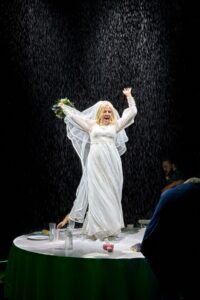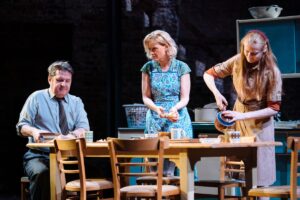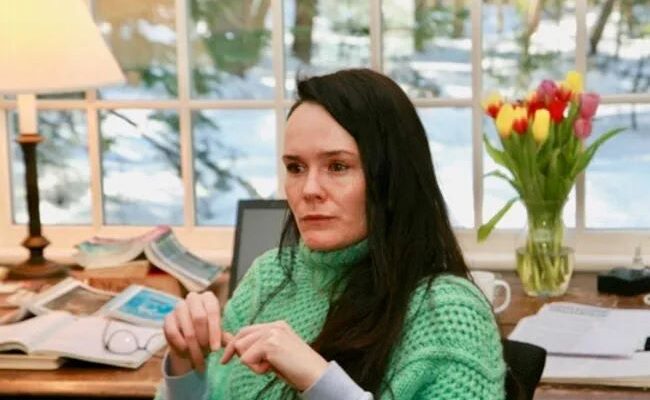She is tall, elegant and carries herself with a natural grace. We met at the National Theatre where her latest play Till the Stars Come Down is currently staged to glowing reviews. The play is set in a wedding day at a family home. It does not take long for the cracks to surface. The dialogues mingle different shades of humour – crude, earthy and spiked with cynicism, pain, and lukewarm affection.
Beth and her twin sister grew up in the Nottinghamshire area, in a small town called Warsop. The aspiration was to get jobs at the age of 16. Their father was a coal miner and the mother kept a warm and beautifully manicured home. At the age of 16 the twin sisters were offered a job in Crete. The parents agreed to a year in Crete on the understanding the girls learn Greek. They came back home at the age of 21, fluent in Greek and with savings to start new life in the big city – London. Steel admits she did lots of waitressing. She earned her living and free time dedicated to exploring art galleries and theatres. ‘I used to buy Time Out when it was then hard copy, and I would circle what I was going to do.’
How did you start your journey to being a playwright?
‘Gosh, in a very, it was a back path, a very unpredictable path, not a road. It never occurred to me that I would be a writer. I’d never written anything at all. I wasn’t even really much of a reader. I didn’t do A-levels, I didn’t do university or college or anything like that.’
She loved school but had no idea what she wanted to do. There wasn’t one teacher that she can recall as ‘inspiring’.
‘Waitressing in London allowed me to do was work in the evening and then in the daytime, go and do art. And I did everything. Go to galleries, go to museums in London.’
London & Paris
At the age of 22 the Glamour of Paris of the 1920s captivated her imagination. The 1920s were a glorious period for Parisian high fashion. A period where new designers challenged the old.
‘I was obsessed with art, with thinking that there was being attracted to that world. You know, when I was 22 I was obsessed with 1920s Paris, for example, and the whole Montmartre area. And I knew everything about every single artist. I knew what streets they lived on. I’d never even been. I used to walk around in vintage dresses in long gloves and hats. I loved the immersion of the world of it.’
The journey to her current achievements was not free of obstructions ‘I have taken a lot of back streets and gone down a lot of cul-de-sacs as well to get here. I didn’t really go and see much theatre, to be honest. I mean, I did see some, but I kind of, I was that person who went to the West End, saw a classic, and saw, and it would have somebody from the television in it somebody who I knew.’ The cost of a ticket to see a play was an obstacle to seeing more theatre. ‘Quite a lot of money in comparison to going for a ticket to an art show or a film.’
Blackbird – a moment of eureka.
‘Somebody told me to go and see Blackbird, by David Harrower, directed by Peter Stein. Within 15 minutes of the performance, I thought this is the most exciting night of my life. Wow. Honestly. She walked in and because it’s a two-hander it’s incredibly tall and fraught. I mean, I couldn’t leave the theatre for 10 minutes afterwards. I was distraught, but also exhilarated. And kind of like, this is what other people my age feel at music gigs, and I’m just bored. Like, this is my music gig. This is my gig.

I felt clenched watching it. It was just utterly, utterly electric. And the strange thing was, I left thinking I could do it, having never written anything. I left thinking, I think I can do it. Which, of course, I couldn’t. But it did something inside me where I’d understood something about dialogue and language. And I think it’s because it was a two-hander. And it was so push and pull between the characters. It’s almost like it made me understand what dialogue is. It’s people wanting things from each other, and how do people get things from each other? And I went and bought the play. And I was obsessed with it. I read it so many times. I mean, maybe 20 times a month. I just kept rereading it. I had it in my handbag for months.
In a way, it taught me how to write, because from having the kind of awe-inspiring, electrifying shock of an experience, I then, reading the text repeatedly, made me start to think about how he’d done it. I started writing about six months later. And what I started writing was dreadful. In fact, it was terrible, and I am not saying this out of humility. It was like whimsy, childish, schoolgirl, but I loved it. I used to come home from my waitressing, and I’d be up until two in the morning. I used to set my alarm for 5 a.m. before I started the day shift. I like, I tumbled head over heels into it. And I’d never done anything that was private just for me. You know what I mean? And I just felt it was a total falling in love. And I kind of let everything fall by the wayside. I did start to write a play and it was completely influenced by the play I was obsessed with’.
Steel sent off her first attempt at writing a play to a few places. The Royal Court responded with an invitation to one of their writing groups. That was incredible. It was an endorsement that I can do it. The group was quite an advanced one. The experiences stimulated creative writing of plays.
Till the Stars Come Down
It took Steel three years with some gaps to write this play. The collaborative work with the director, set designer and lighting director is crucial to the success of any production.
Do you draw on your blank page?
‘No. I start with nothing. I go straight in. I don’t structure. I don’t plan. Rather than trying to predict from the outside – Act one, act two, act three, I don’t know what’s gonna happen.
The characters know, the whole universe of the play knows, and I just must do the work of listening and waiting and uncovering it, do you know what I mean? When I write, I don’t have a clue even before I put the pen to paper what I’m going to write, and it just comes out. When you create your characters, when your characters come to life, they start talking, and you, quick enough, you can identify that there are different characters because they’ve got different languages. They probably start more similar, and then they get more different once I understand who they are. I felt, from the very beginning, I had a very clear idea of Sylvia, and then it took longer for the other two to branch them out differently. The seeds of the entire play are in the first scene. You must be able to watch the whole play, get to the end, then read the first scene again, and go, ah, so she did see it, she did. We missed that. I redraft obsessively.’
Steel shares one of the scenes she so vividly experienced in her dreams – the wedding scene –
‘I had a dream one night, really, really early on, in writing the play. I had fragments of notes and thoughts. And then I had this dream one night, I saw a wedding table, but it was a long one, and a bride and groom in the middle, and I saw this sort of huge, like applause and laughter, and I saw the bride do this. And everyone froze. And she sat down and took in the moment of complete happiness. And then a drop of rain landed in a glass. Another drop, another drop, another drop. The heavens opened. I dreamt that.

The accomplished theatre and opera director Bejan Sheibani was appointed to direct Beth Steel latest play.
‘I felt incredibly grateful that Bejan wanted to direct this play. He’s a very collaborative director. He absolutely knows what he wants, but he is also up for hearing your thoughts as well’.
Characters in the plays
Steel explains something of the process of forming the characters she presents in her plays.
‘I tend to hear one voice, very clear, early on of one of the characters. I hear the voice, and it is usually the leading character. I tend to write ensemble plays, so there is, like in Till the Stars Come Down, I don’t think there is a lead character. It is lots of lives.’
She first determines where the plot is set. ‘In the House of Shades, I knew it was a house, and that it was through time, that it was through decades. Till The Stars Come Down, I knew it was a wedding. So I sort of have a backdrop.’
The voices of the characters have a life of their own. ‘They start to come out of that backdrop. Sometimes I have to wait a very long time for the characters. I couldn’t be writing a play every single day for seven months, and I’ve still not heard a voice of a particular character. I just can’t get it right. I just can’t hear it properly. I don’t know who they really are. I know who they are in a sort of surface way, but I don’t know them in a way of like living with them. Their little, tiny habits.’
We then discuss the creation of some of the characters. Steel loved each character. Here are just two example to illustrate the point:
‘Auntie Carol performed by Lorraine Ashbourne, is absolutely amazing. She is absolutely a stereotype but at the same time very individual. Lorraine Ashbourne is as hysterical in real life. She’s an extraordinary actress. She can give you Clytemnestra. She can and did give you Olga from Three Sisters. She is a big-gun actress. And she’s so not afraid to go for it. She has the audience eating out of the palm of her hand within ten minutes every single night. I had great fun writing Auntie Carol.
I mean, she just made me laugh all the time I was writing her. She’s like a glue in the piece. She holds up the universe of the play. No character is the main protagonist but she’s this glue figure coming in and coming out. She changes the chemistry of the room when she leaves and when she comes.
Hazel is quite a set character. Because she oversees everything and she’s not in charge of anything. She comes in and you think she’s in the centre. But she’s in the peripheral of the whole stage. She’s a person who is terrified of change. That’s a very frightening thing because change is happening all the time, and you can’t control it.’ Says Stee and adds ‘I loved writing Hazel. I love writing all of them ‘.
A writer in residence at the National Theatre
The National Theatre lives up to its name – embracing artistic talents and actively encouraging artists and young audiences to appreciate the performing arts. One of its numerous projects is ‘A writer in residence’. The Head of Play Development is Nina Steiger.
To explore something of that position I asked Beth Steel how did she get the position? what did it mean to her?
‘Nina Steiger contacted me. She has seen my play The House of Shades at the Almeida. I was asked if I would like the position of ‘A writer in residence’ for one year.

Obviously, I thought it would be great. I had no idea how life-changing it would be. First, just to speak crudely, but importantly, I got a salary. And I don’t do lots of screen work, which is what an awful lot of playwrights have to do to stay afloat. Unless you’re having multiple productions all over the world, but I’m not. Everything I write goes on, but it goes on in three years’ time, do you know what I mean? So to have that was a huge financial liberation. For one year but for me, I can last on that for three years. What other people take this time, I can make that work, and you get a studio space.’
The studio with doors to a new world
The studio-office she is offered is a beautiful large space next to the Old Vic where all the workshops happen. She gets to see rehearsals of new plays and attend workshops.
‘I can be the writer in residence upstairs and I get to find out that PJ Harvey, Ian Rickson, Ben Power are doing a sharing of one of their workshops for the work that they’ve done.’
And there is the luxury of attending reading and discussion of new plays. ‘You also become what is called the associates meeting which is once a month. And that is the meeting which starts the decisions about what plays are going to go on. So, the associates read two plays, sometimes three, but normally two plays to then go under consideration and everybody in the room must express their opinion about the play, which is terrifying when you first do it because it’s like stepping into a gladiatorial arena. You really must know what you’re talking about.’ That exposure ‘taught me I didn’t know how to read a play.’
The challenges offered by the group reading of a play helps one acquire the confidence to analytically criticise even ‘somebody who is famous’.
*Blackbird was commissioned by the Edinburgh International Festival and the Institute for Advanced Studies in the Humanities at the University of Edinburgh. It was premiered in 2005 at the festival. Directed by Peter Stein. In February 2006, it opened at the West End Albery Theatre with Roger Allam and Jodhi May.
** The House of Shades (2022 premiered at the Almeida Theatre)

